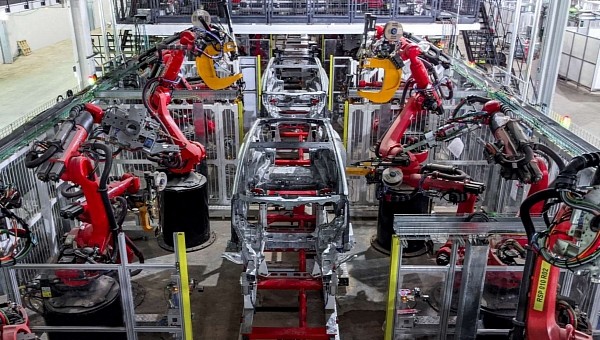In January 2022, Elon Musk said Tesla would grow 50% that year and would repeat that percentage annually. After it released Q4 2022 results, we can say that’s another target the CEO set for his company and missed. Unlike robotaxis, Tesla was pretty close to reaching this goal: it delivered 40.34% more than in 2021. Analysts bet on much higher numbers.
FactSet compiles financial analysts' guesses. According to CNBC, they were between 409,000 and 433,000 units. Troy Teslike tweeted that analysts were estimating 417,957 deliveries. The actual number was inferior to all these estimates: 405,278 EVs met their owners in Q4 2022. Ironically, Tesla never delivered so many cars in a single quarter. The issue here is that people expected more, which is always bad news.
Interestingly, production was much higher than that: 439,701 cars. In a year-over-year comparison, that led to 1,369,611 units. When we learn that the total production number in 2021 was 930,422 EVs, that's a 47.2% increase, which suggests that Tesla produced more cars than it could sell.
In 2021, Tesla delivered 936,222 cars, or 5,800 EVs more than it manufactured that year. In 2022, it handed 1,313,851 vehicles, which created a stock of 55,760 units. It is not a surprise that the company’s backlog is dropping at an accelerated pace.
Tesla is trying to improve it in several ways. In China, it replaced the government subsidy for discounts on insurance and transportation costs. In the U.S., the EV maker is allegedly developing cheaper versions of its cars. That may make them eligible for the new $7,500 federal tax credit established by the Inflation Reduction Act.
Deliveries may also have been lower than production because several Tesla customers refuse to take delivery of their cars due to defects. Tesla never disclosed the percentage of vehicles customers reject, but that would be an interesting indicator of how much money the company could save with better quality control.
A while ago, some people could oversee these flaws to be able to resell the cars at prices higher than those Tesla was selling them for. The demand drop affected these business opportunities and made the products of the EV maker depreciate more than other used cars. Anyone getting them will lose money, as all new-car buyers do. Depending on how many repairs these vehicles will have to face – and how serious they are – they may depreciate even more. In Germany, Tesla allegedly delivered new cars with cracked jacking points at least twice.
Tesla has two new factories still gaining speed to produce vehicles people are not so thrilled anymore to buy. That may create a repetition in Q1 2023, with amazing production numbers and frustrating delivery figures, forcing Tesla to renovate its lineup or adjust manufacturing capacity. Next March 1, 2023, Tesla will hold its 2023 Investor Day to discuss “long-term expansion plans, generation 3 platform, capital allocation, and other subjects.” Some investors may use the opportunity to ask Musk why the company’s shares depreciated 69% in the last 12 months.
Interestingly, production was much higher than that: 439,701 cars. In a year-over-year comparison, that led to 1,369,611 units. When we learn that the total production number in 2021 was 930,422 EVs, that's a 47.2% increase, which suggests that Tesla produced more cars than it could sell.
In 2021, Tesla delivered 936,222 cars, or 5,800 EVs more than it manufactured that year. In 2022, it handed 1,313,851 vehicles, which created a stock of 55,760 units. It is not a surprise that the company’s backlog is dropping at an accelerated pace.
Tesla is trying to improve it in several ways. In China, it replaced the government subsidy for discounts on insurance and transportation costs. In the U.S., the EV maker is allegedly developing cheaper versions of its cars. That may make them eligible for the new $7,500 federal tax credit established by the Inflation Reduction Act.
Deliveries may also have been lower than production because several Tesla customers refuse to take delivery of their cars due to defects. Tesla never disclosed the percentage of vehicles customers reject, but that would be an interesting indicator of how much money the company could save with better quality control.
A while ago, some people could oversee these flaws to be able to resell the cars at prices higher than those Tesla was selling them for. The demand drop affected these business opportunities and made the products of the EV maker depreciate more than other used cars. Anyone getting them will lose money, as all new-car buyers do. Depending on how many repairs these vehicles will have to face – and how serious they are – they may depreciate even more. In Germany, Tesla allegedly delivered new cars with cracked jacking points at least twice.
Tesla has two new factories still gaining speed to produce vehicles people are not so thrilled anymore to buy. That may create a repetition in Q1 2023, with amazing production numbers and frustrating delivery figures, forcing Tesla to renovate its lineup or adjust manufacturing capacity. Next March 1, 2023, Tesla will hold its 2023 Investor Day to discuss “long-term expansion plans, generation 3 platform, capital allocation, and other subjects.” Some investors may use the opportunity to ask Musk why the company’s shares depreciated 69% in the last 12 months.
Tesla's survey with 24 sell-side analysts is out (also known as the company-compiled consensus). Analysts are estimating 417,957 deliveries in Q4 on average. This is a more up-to-date estimate and replaces the old analyst consensus that was a little higher. pic.twitter.com/kMqCCGgJWP
— Troy Teslike (@TroyTeslike) December 30, 2022










